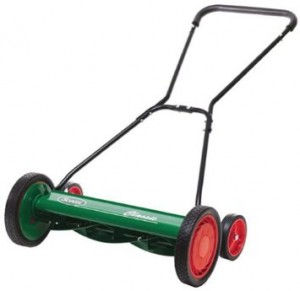It’s our first full summer since moving into this house, and time to buy a lawn mower. I envisioned spending $300 on a gas mower, but in the end spent less than half that for a good old fashioned reel mower. (The cheapest ones were $70, but we splurged for a fancy $130 model.)
This is full of advantages and has no discernible disadvantages.
First, it uses no gas. There’s a cost savings, an environmental savings, and a noise savings. I can mow the lawn whenever I want and bother nobody, and I don’t spew pollution into the atmosphere every time I do it. This is what got me looking in the first place and it’s a big selling point.
Second, it’s inherently a “mulching mower”. It doesn’t leave ugly rows of grass clippings or require disposing of bagged clippings. It conveniently leaves the clipped grass right where it started, where it serves as fertilizer for the lawn.
Third, it’s faster and easier to use. For straight rows of grass it’s no easier or harder than a gas mower; you just push it down the row. (And no, it’s not even a tiny bit hard to push.) But it corners more easily and can handle edges that might be dangerous for a gas mower. For example, I can push it more slowly over rocks, so if one does get kicked it up won’t do any harm — a gas mower would kick the thing right up.
I can mow our entire yard, front and back, in about 10 minutes. That’s about as much time as our neighbors spend yanking fruitlessly on the starting cord for their gas mowers.
